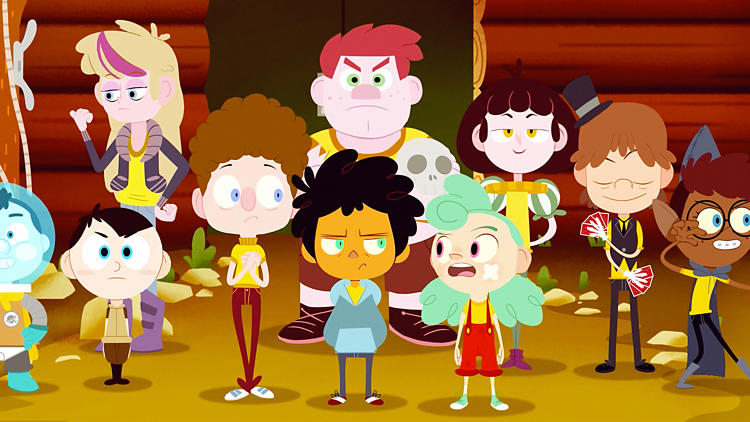How Rooster Teeth’s “Summer Of Animation” Is Going To Forever Reshape Its Future
Fourteen years ago, Rooster Teeth’s animation department was five guys in Burnie Burns’s apartment with an Xbox, recording footage of themselves playing Halo and putting in audio of the jokes they cracked on top of it. It was a lo-fi beginning, but it was enough. The show they launched off of that, Red vs. Blue, became an institution—finding release on DVD, Blu-ray, and syndication, in addition to its web presence—and has spanned a whopping 14 seasons.
It’s also spawned Rooster Teeth into a powerhouse entertainment company and—in addition to projects like the feature film Lazer Team, its growing comedy and games divisions, and its first live-action “prestige” drama series nearing debut—an animation department so sizable that they’re preparing to move into their own facilities a few miles away from Rooster Teeth’s home at Richard Linklater’s Austin Studios.
At the moment, Rooster Teeth Animation boasts 70 employees—growth that’s downright meteoric, considering the company’s humble roots. Most of that growth is recent, too. Around the time of Red vs. Blue season 10, the company began scaling up big time, and they haven’t really stopped since.

The Rooster Explosion
Gray Haddock, the head of Rooster Teeth Animation, is still staggered when he talks about it. “About five years ago, it turned into a little over a dozen people, maybe 15, at the start of season 10 of RvB. By the time we move into our own space, Rooster Teeth Animation will be bigger than the company as a whole was when Rooster Teeth moved onto the Austin Studios lot two years ago,” he says. “Just to give you a sense of how quickly we’ve exploded.”
That explosion is still very much in progress, too. By 2017, Rooster Teeth Animation could nearly double in size again—Haddock anticipates being at 125 or more next year—and the number and kinds of projects it’s taking on along with that growth reflect a company that’s reached a turning point. What started with Xboxes and “machinima” animation, or animation built around real-time computer graphics engines, usually found in video games, hasn’t entirely evolved past it—Red vs. Blue is entering its 14th season, and while the series stopped relying exclusively on machinima several years ago, that legacy is still very much a part of the show—but it is much, much more than video game parodies now.
In 2009, animator and game designer Monty Oum took over Red vs. Blue, and the company kept under wraps that he’d be shifting the show to include custom animation. The season launched with an episode that appeared to be standard machinima animation, until, at one point, an action sequence concluded with a vehicle crashing through the scene that couldn’t be done inside the video game. (“I remember being in my college dorm room watching that episode and going, Kyle, come here. Kyle, you gotta come see this!” Rooster Teeth animator and director Miles Luna recalls. “Kyle [Taylor] is one of our directors now, too.”) Oum was a big presence at Rooster Teeth—not only did his vision for Red vs. Blue redefine and breathe new life into the flagship series, but he pushed the company to new frontiers with the fully original anime series RWBY.
Oum passed away in 2015, after an allergic reaction during a medical procedure. But his spirit is very much alive at Rooster Teeth Animation. “Toward the end of RvB season 10, Monty floated the idea, in order to keep himself sane, of what it would take to do your own custom CG anime,” Haddock explains. “He went ahead and started bouncing stray ideas off of Miles and Kerry [Shawcross], and they went ahead and animated a concept short that he showed to [cofounders] Matt [Hullum] and Burnie, in order to get the idea across. They took a look at it and went, ‘Well, that’s greenlit.’ And that’s how the show RWBY began.”
Oum left Red vs. Blue to take on RWBY, but the Halo-themed comedy series is still Rooster Teeth’s flagship. (“As long as the fans are watching it, we still want to make it,” Haddock says.) That put the company in a position where it had to start expanding—suddenly, the company was trying to do two 3-D animated shows a year, as well as the 2-D anthology series Rooster Teeth Animated Adventures. In 2014, after RWBY turned out to be a success, they launched X-Ray and Vav—a series about two wannabe superhero kids—bringing their total up to four shows. “Now, at any given time, we’ve got at least a major 3-D show and a 2-D show in production,” Haddock says. “We’re in preproduction on the next one, and we’re developing the concept for shows that are still 12 to 18 months out.”
Spreading Its Wings
At this point, Rooster Teeth animation has six shows in active production. There’s Red vs. Blue season 14, and RWBY Chibi—a cute, family-oriented series for younger viewers who may not be ready for the dark turn that the core RWBY series is taking—both of which premiered in May. There’s also RWBY season four, which is in preproduction, and the premiere of Camp Camp, a 2-D comedy series launching on June 10. On top of all of that, Rooster Teeth Animated Adventures and the community-based machinima show Minimations are still in production—and Haddock teases “at least two new shows, one 3-D and one 2-D, that are in concept phase right now” that he anticipates debuting in 2017.
It’s not bad for a company that started with people doing funny voices while they played Halo in some dude’s living room.
These days, Rooster Teeth Animation is set up in one of the numerous lots in the former airplane hangar that is Austin Studios. By the fall, they’ll be set up a few miles away, in a converted strip mall near the highway that divides East Austin from Central Austin. But right now, touring the animation studios is a little bit like visiting what you’d find if someone mashed up a Hot Topic with an Apple Store. The walls are painted black, and the lights are low. There is a sea of computer monitors with bleary-eyed animators, writers, directors, and others working on them. Sometimes that means they’re designing characters and vehicles; sometimes that means they’re watching South Park or old NFL highlights looking for the right inspiration. Everybody’s desk seems to have an impressive toy collection, with collectibles, action figures, and replica weapons that seem to have come straight from Japan. Behind all the computers, there’s the motion-capture studio, full of athletics equipment and big enough that a handful of stunt performers (up to six at a time) can use that equipment to perform the moves that the heroes of RWBY or Red vs. Blue might undertake in their adventures. It’s a neat place to be, and the fact that it’s a giant, windowless airplane hangar helps keep it feeling a little bit like a Vegas casino—you can never really tell if it’s day or night in the Rooster Teeth studio, which is good, because the hours can be very long.
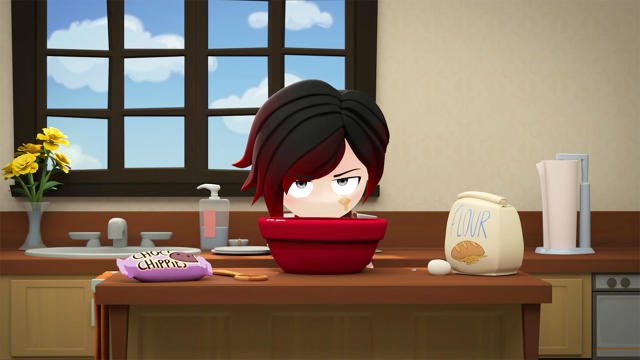
More Projects, More Problems
As the animation studio has grown, the stakes have changed. For Luna, those long hours aren’t always spent hunched over his computer anymore. Now that he’s part of a team of 70 people, the old guard of animators has taken on new roles and responsibilities—and new anxieties.
“It used to be that a long day at Rooster Teeth was literally a long day at Rooster Teeth,” he says. “We still have those days for sure, but now it’s at a breakneck speed all day of running from one group of people to another—talking with animators, talking with layout, talking with sound, getting our musicians and composers and Skype, and then having a storyboarding session. It’s a lot more movement and a lot less sitting down at one desk doing everything. It’s fun—but it’s also stressful. When you’re the person that has to do everything, then you’re the one that’s making yourself work late, and you’re the one that, if you screw up, you have to go back and fix it again. Now, if you make a mistake or if you misdirect somebody, then it affects their time and then they’re the ones staying late.”
A lot has changed for the animation team at Rooster Teeth in recent years, and not just in terms of size. Luna and Shawcross both started as interns. Jordan Cwierz, another one of the animation studio’s directors, came in as a fan who posted 2-D animations online and got a call offering him a job. Haddock started with visual effects, then transitioned into editing and producing, before finally heading the department upon its formation. “In one way or another, we’ve all been getting opportunities to come in and help on a small scale, and then just had it take off from there,” Haddock says. “Five years ago, we weren’t a department. We were just the geeks in the corner who, a couple times a year, were tasked with figuring out how to make the next show.”
At some point, Rooster Teeth Animation is going to change into something even bigger. They’ve moved out of the corner and into the main hangar. They’ll be moving into their own space soon—and, eventually, they recognize that they may even move beyond the in-house team that they’ve built now.
“We don’t know how long we’re going to be able to keep all the animation in-house,” Haddock admits. “That’s something we’ve been able to pride ourselves on up to this point, but as Rooster Teeth Animation continues to want to raise the bar in terms of the quality of the look and feel of its shows, and just make cooler stuff faster, eventually we’re going to have to start looking outside for some additional assistance, depending on exactly what subject you’re talking about.”
Haddock and his team are clear that the key word there is “additional”—there’s a lot of pride in being the only animation studio of its kind in Austin—”everything else is either corporate video game development animation, advertising, or business-to-business”—and in the flexibility that being fully staffed in-house gives them. But managing growth is challenging, and the kind of growth that Rooster Teeth Animation has experienced especially so.
“I guess the more succinct way to put it is that we’re going to keep growing the department for as long as the powers-that-be let us,” Haddock says. “It lets us execute much more quickly. Everybody gets much more invested in the show knowing that it was you and the people sitting right around you that are responsible for everything that makes it up on-screen.”
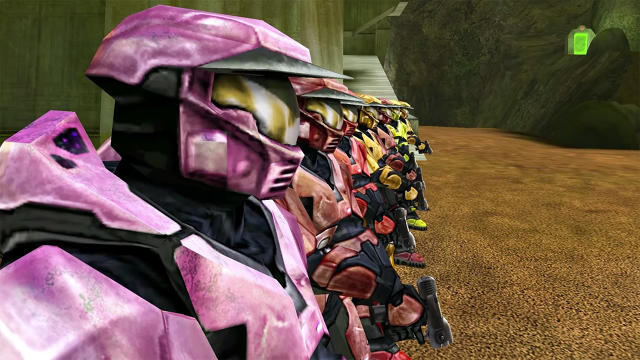
Random Dudes No More
In that way, what Rooster Teeth Animation does now isn’t too far off from what it did when it was just the collection of random dudes in Burns’s apartment playing Halo—the idea that a community of geeks in the corner can build something that the world wants to see, and it keeps growing, is an exciting one for the Rooster Teeth team. And as Rooster Teeth Animation expands, they’re optimistic that the company knows that keeping true to those roots—while consistently getting bigger and better—is the key to managing the challenge of growing so fast.
“Matt and Burnie give us an amazing amount of control,” Shawcross says. “They’re adamant about us continuing to expand and very supportive about it.”
That extends to everything—from the constant hiring of new animators to the upcoming new facilities to the voice talent they’re working with. And that last part is a fine microcosm for what Rooster Teeth Animation might be, as it grows, too—going from a fully homegrown entity to one that taps the talents of the wider world doesn’t have to be a bad thing, after all.
“It used to be, the voices were all Rooster Teeth employees,” Haddock recalls. “Then it was Rooster Teeth employees, their friends, and the local theater and improv comedy actors that they could find. Then, on top of that, you start to add some professional voice actors. Now, these days, we can start casting on either coast if we need to. At this point, the sky is the limit. What’s Mark Hamill doing these days?”
Rooster Teeth’s Camp Camp

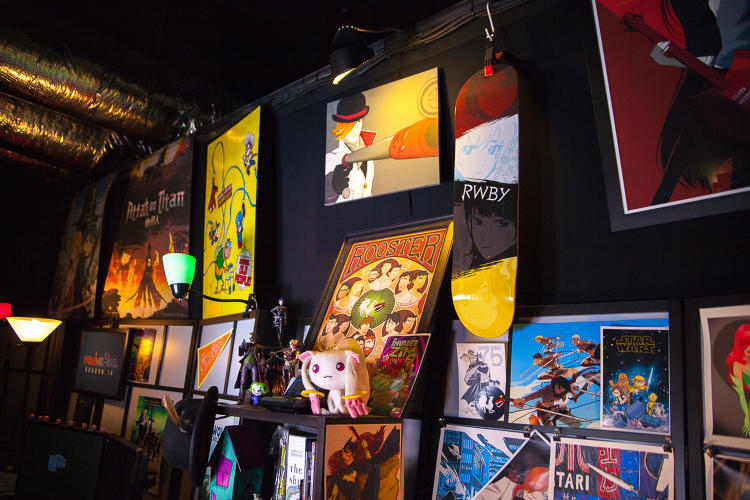

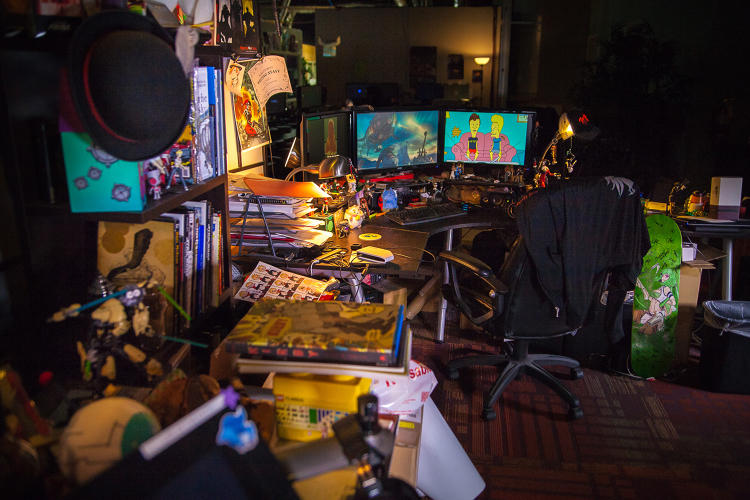
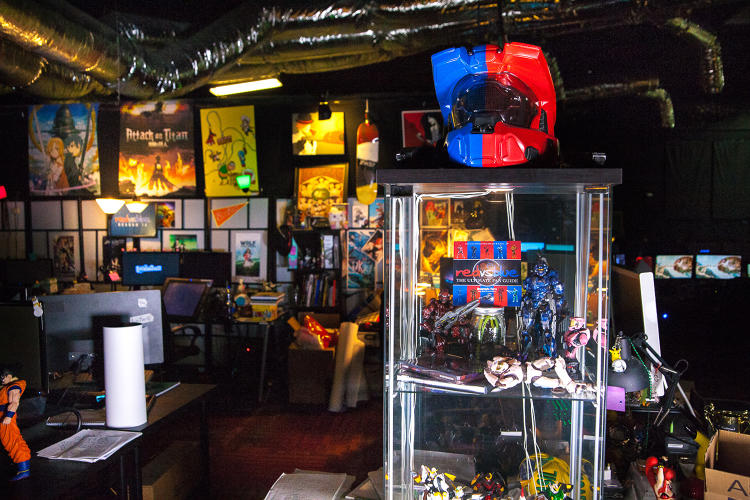
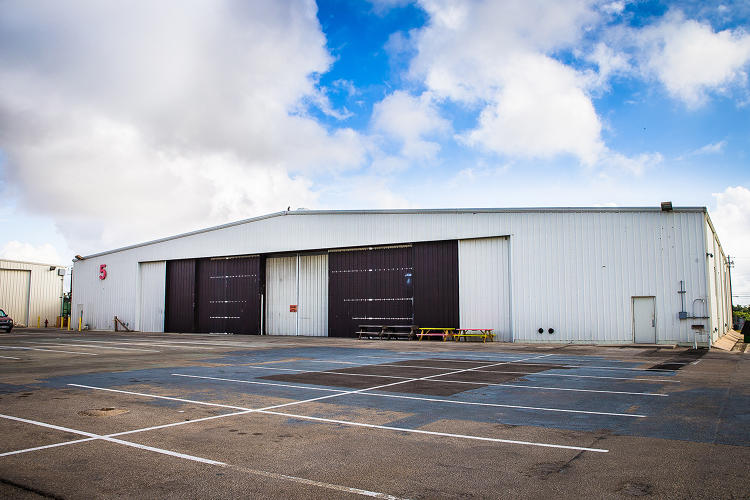
Fast Company , Read Full Story
(135)


